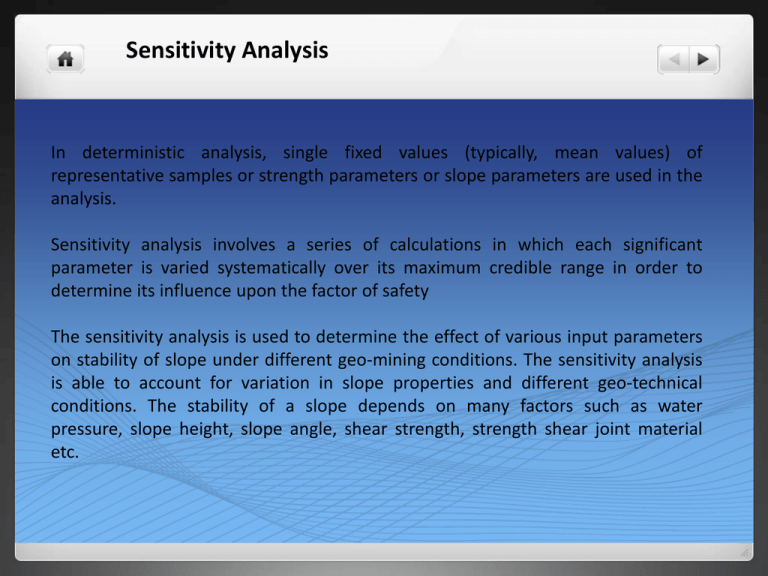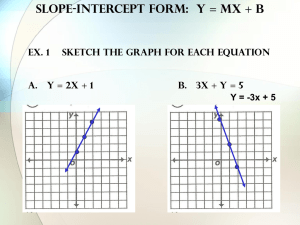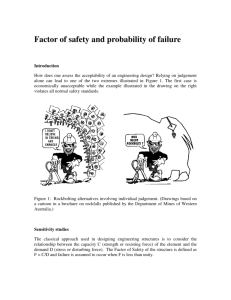Sensitivity, Probability and reliability analysis
advertisement

Sensitivity Analysis
In deterministic analysis, single fixed values (typically, mean values) of
representative samples or strength parameters or slope parameters are used in the
analysis.
Sensitivity analysis involves a series of calculations in which each significant
parameter is varied systematically over its maximum credible range in order to
determine its influence upon the factor of safety
The sensitivity analysis is used to determine the effect of various input parameters
on stability of slope under different geo-mining conditions. The sensitivity analysis
is able to account for variation in slope properties and different geo-technical
conditions. The stability of a slope depends on many factors such as water
pressure, slope height, slope angle, shear strength, strength shear joint material
etc.
In sensitivity analysis a common approach is that of changing one-factor-at-a-time
(OAT), to see what effect this produces on the output. This appears a logical
approach as any change observed in the output will unambiguously be due to the
single factor changed. Furthermore by changing one factor at a time one can keep
all other factors fixed to their central or baseline value.
This increases the comparability of the results (all ‘effects’ are computed with
reference to the same central point in space) and minimizes the chances of
computer program crashes, more likely when several input factors are changed
simultaneously
Sensitivity is expressed by a dimensionless index I, which is calculated as the
ratio between the relative change of model output and the relative change of a
parameter. The sensitivity index (I) as defined by Lenhart (2002) is expressed
in equation given below.
Schematic of the relation between an output variable y and a parameter x.
Probability density function
Probabilistic analysis in slope stability involves quantity the task of quantitatively the source
uncertainty. A probabilistic analysis is based on a correct randomness determination of the
parameters affected by uncertainties. Therefore, the probability density function of each of the
random variable is demined which governs the stability problem.
The variable associated with slope design are uncertain due to many reasons. Therefore, to
account for uncertainty the probabilistic method can be used for assessing the stability of
slope. These are many source of uncertainty in slope stability analysis. The amount of
uncertainty varies from one analysis to another and from one site to another. These
uncertainties are
• Site topography
• Site straitegraphy and variability
• Geologic origins and characteristics of subsurface materials
• Groundwater level.
• In- situ soil and /or rock characteristics
• Engineering propertics
• Soil & rock behavior
Probability density function
The arithmetic mean, often referred to as simply the mean or average. Suppose the data
{
}. Then the arithmetic mean
is defined via the equation as
The variance describes the extent of the range of the random variable about the mean and is
calculated as
The standard deviation ( ) is given by the positive square root of the variance
. A small
standard deviation will indicate a tightly clustered data set while a large standard deviation will
be found for a data set in which there is a large scatter about the mean.
Probability density function
The coefficient of variation (COV) is the ratio of the standard deviation to the mean. It is
dimensionless and it is a particularly useful measure of uncertainty. A small uncertainty would
typically be represented by a COV = 0.05 while considerable uncertainty would be indicated by a
COV = 0.25.
If a pair of random variables (X and Y, for example) depend on each other, the variable X and Y
are considered to be correlated, and their covariance is defined by
This covariance is very similar to the variance. If the covariance is normalized by the standard of
the X and Y variable, the correlation coefficient,
, may be described by
Probability density function
Probability density function (PDF) of a continuous random variable is a function
that describes the relative likelihood for this random variable to occur at a given
point.
The PDF for the normal distribution with a mean, u, and deviation
defined by This
distribution is symmetric about the mean, and the random variable can take on values between -
Probability density function
• Beta distributions are very versatile distributions which can be used to replace
almost any of the common distributions and which do not suffer from the
extreme value problems discussed above because the domain (range) is
bounded by specified values.
• Exponential distributions are sometimes used to define events such as the
occurrence of earthquakes or rockbursts or quantities such as the length of
joints in a rock mass.
• Lognormal distributions are useful when considering processes such as the
crushing of aggregates in which the final particle size results from a number of
collisions of particles of many sizes moving in different directions with
different velocities.
• Weibul distributions are used to represent the lifetime of devices in reliability
studies or the outcome of tests such as point load tests on rock core in which a
few very high values may occur
Probability density function
Probabilistic Slope Stability Analysis Methods
General Monte Carlo Simulation Approach
Monte Carlo method
It uses random or pseudo-random numbers to sample from probability
distributions. The large numbers of samples are generated and used to calculate
factor of safety.
The input parameters for a Monte Carlo simulation fall into two categories, the
deterministic parameters used for a conventional analysis and the parameters
which define the distribution of the input variables. For slope stability analysis the
deterministic parameters are:
•
•
•
•
•
•
•
Critical Height (H) or Factor of Safety (FS)
Slope Angle from the Horizontal Plane (β)
Angle of Friction (φ)
Cohesion (c)
Unit Weight (γ)
Saturated Unit Weight (γ Sat)
Submerged Unit Weight (γ ′)
The Monto Carlo simulation follows a four step process:
For each component random variable being considered, select a random
value that conforms to the assigned distribution.
Calculated the value of the FOS using the adopted performance function
and the output values obtained from step1.
Repeat steps 1 and 2 many times, storing the FOS result from each must
calculation.
Use the many calculated FOS values from the Monto Carlo simulation to
some timate (a) the probability, (b) the sample mean and variance, and
(c) the FOS PDF from the histogram.
Point Estimate Method
It is an approximate numerical integration approach to probability
modeling. The Generalised Point Estimate Method, can be used for rapid
calculation of the mean and standard deviation of a quantity such as a
factor of safety which depends upon random behaviour of input variables.
To calculate a quantity such as a factor of safety, two point estimates are
made at one standard deviation on either side of the mean (μ ±σ ) from
each distribution representing a random variable. The factor of safety is
calculated for every possible combination of point estimates, producing
2n solutions where n is the number of random variables involved. The
mean and the standard deviation of the factor of safety are then
calculated from these 2n solutions
Reliability Analysis
The reliability of a slope (R) is an alternative measure of stability that considers
explicitly the uncertainties involved in stability analyses. The reliability of a slope is
the computed probability that a slope will not fail and is 1.0 minus the probability of
failure:
R=1-Pf
The lognormal reliability index,
using equation given below:
, can be determined from the values of
and
Reliability Analysis
Two common methods of calculating the coefficient of reliability are
• Margin of safety method
• Monte Carlo method
Margin of safety method
If the resisting and displacing forces are mathematically defined probability
distributions and respectively it is possible to calculate a third probability
distribution for the margin of safety. If the lower limit of the resisting force
distribution fD(r) is less than the upper limit of the displacing force
distribution fD(d).
Mean, margin of safety =
Standard deviation, margin of safety=
where fD(r) and fD(d) are the mean values, and σr and σd are the standard deviations of the
distributions of the resisting and displacing forces respectively.
Reliability Index
Monte Carlo analysis
The examined problem variables are generated by these random numbers in such a
way as to respect the assumed probability distribution curves.
1 Estimate probability distributions for each of the variable input parameters.
2 Generate random values for each parameter; between 0 and 1 and the
corresponding value of the parameter.
3 Calculate values for the displacing and resisting forces and determine if the
resisting force is greater than the displacing force.
4 Repeat the process N times (N > 100) and then determine probability of failure
Pf from the ratio
where M is the number of times the resisting force exceeded the displacing force (i.e.
the factor of safety is greater than 1.0).







